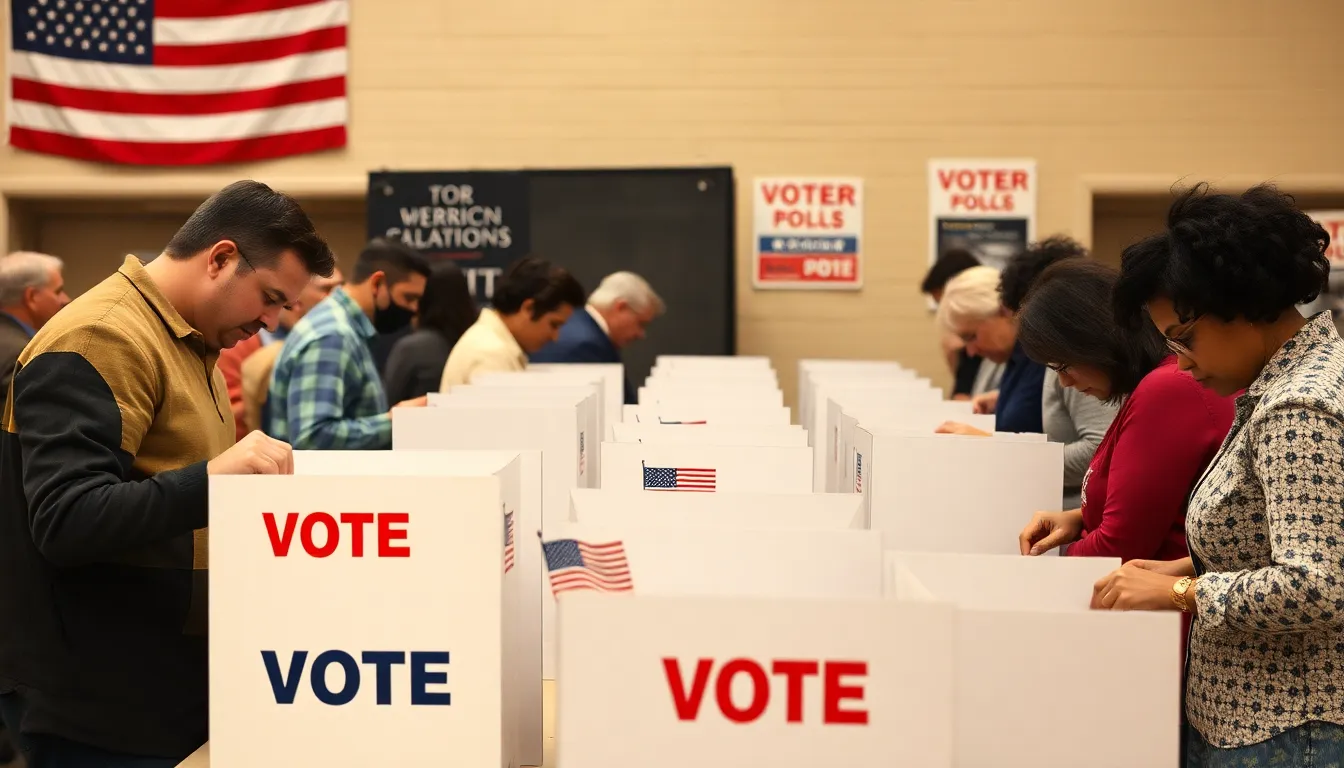When it comes to Pennsylvania, the question isn’t just about cheesesteaks or the Liberty Bell—it’s whether this state leans red or blue. Known for its rich history and diverse landscapes, Pennsylvania’s political identity can be as complicated as a game of Monopoly played by a family of four. One minute, it’s waving a Republican banner, and the next, it’s decked out in Democratic blue, leaving everyone scratching their heads.
In the battleground of American politics, Pennsylvania plays a pivotal role. With its mix of urban centers and rural heartlands, the state reflects a microcosm of the nation itself. As elections roll around, understanding its political leanings becomes crucial. So, is Pennsylvania a red state or a blue state? Let’s dive into the colorful world of Keystone politics and find out what makes this state tick.
Table of Contents
ToggleOverview of Pennsylvania’s Political Landscape
Pennsylvania exhibits a diverse political landscape characterized by both Republican and Democratic factions. Urban areas, such as Philadelphia and Pittsburgh, tend to lean Democratic due to their larger populations and progressive values. In contrast, rural regions align more closely with Republican ideals, emphasizing traditionalism and individualism.
Shifts in party allegiance can be observed during election cycles, reflecting the state’s role as a battleground. Voter turnout influences outcomes significantly. In the 2020 presidential election, approximately 80% of registered voters participated, showcasing the state’s political engagement.
Demographic factors further contribute to Pennsylvania’s political complexities. The state is home to a significant population of working-class voters, particularly in the Rust Belt. Their concerns about job security and economic stability shape local political priorities.
Recent polling data illustrates fluctuating support among party lines. For instance, a 2022 poll indicated that 49% of likely voters favored Democratic candidates, while 45% preferred Republicans. Such data highlights the competitive nature of elections in this region.
Analyzing legislative decisions reveals underlying trends in governance. Policies concerning healthcare, education, and energy resonate with constituents, ultimately affecting party support. As the state continues to evolve, shifts in demographics and priorities will likely result in changes to its political landscape.
Historical Voting Trends

Pennsylvania’s voting history reflects significant shifts, influenced by various elections and changing demographics. Examining key elections reveals the importance of understanding these fluctuations.
Key Elections and Their Impacts
The 2016 presidential election marked a notable shift when Donald Trump secured Pennsylvania’s electoral votes. This victory emphasized the state’s swing status, showcasing the effectiveness of his messaging among working-class voters. Voter turnout played a crucial role; about 78% cast ballots, indicating strong engagement. In contrast, the 2020 election saw Joe Biden reclaim the state with tailored outreach to diverse communities. Biden’s win highlighted the significance of urban areas. The differences in voter mobilization strategies continue to shape election outcomes and reflect evolving priorities within the state.
Shifts in Party Dominance
Party dominance in Pennsylvania has fluctuated over the decades. The state leaned Democratic from the 1930s until the 1960s, aligning more with national trends. In the 1980s and 1990s, however, Republicans gained ground, evident through gubernatorial and congressional wins. Recent elections illustrate an ongoing tug-of-war. The 2022 midterms reflected this trend with Democrats winning several competitive districts while Republicans retained strongholds in rural areas. Demographic changes, particularly in suburban regions, contribute greatly to this volatility, making shifts in party allegiance likely in future elections.
Demographic Breakdown
Understanding the demographic landscape of Pennsylvania reveals its intricate political divides. The diversity of its population significantly influences election outcomes.
Urban vs. Rural Voters
Urban voters typically align with Democratic ideologies, driven by issues like social justice and public services. Cities such as Philadelphia and Pittsburgh showcase this trend, with strong Democratic voter bases. Conversely, rural areas lean towards Republican values, prioritizing economic growth and traditional social structures. These regions often emphasize individual liberties and agricultural interests.
Approximately 80% of registered voters engaged in the 2020 presidential election, showcasing the importance of both demographics in shaping policies and electoral strategies. Democrats thrive in urban settings where higher population densities yield energetic campaign efforts, while Republicans draw support from rural areas that value conservative principles.
Key Population Segments
Key segments within Pennsylvania’s population present distinct political preferences. Working-class voters represent a substantial force, particularly in Rust Belt communities. Economic issues resonate deeply with these voters, fueling concerns about job security and manufacturing stability.
Additionally, suburban areas exhibit shifting allegiances, with some segments increasingly supporting Democratic candidates. Young voters in urban districts prioritize progressive stances on issues like climate change and healthcare, while older voters often prefer stability and conservative fiscal policies. Overall, the interplay among these key population segments shapes the state’s evolving political narrative, demonstrating the complexity of Pennsylvania’s identity in the electoral landscape.
Recent Election Results
Pennsylvania’s election results illustrate its role as a swing state, reflecting varied political sentiments across urban and rural areas.
2020 Presidential Election
The 2020 presidential election showcased Pennsylvania’s significance, with Joe Biden winning the state by securing 50% of the votes compared to Donald Trump’s 48.8%. Urban areas, particularly Philadelphia and its suburbs, drove Biden’s success through increased voter turnout. Voter mobilization efforts were crucial, as many young people and people of color participated actively. This election underscored the critical role of Philadelphia’s electoral strength, emphasizing that urban voters can tip the balance in statewide races.
2022 Midterm Elections
In the 2022 midterm elections, Democrats made notable gains, winning key congressional seats in competitive districts. Approximately 54% of Pennsylvania voters backed Democratic candidates, signaling a shift from 2020, where Republicans had a strong showing. Suburban areas played a pivotal role, with many voters responding to issues like abortion rights and economic concerns. Increased turnout among young voters contributed to this outcome, indicating a growing engagement with progressive issues in the state. As a result, this election highlighted the continued evolution of Pennsylvania’s political landscape.
Current Political Climate
Pennsylvania’s political landscape shows a complex mix of influences that reflect broader national trends. Voter concerns relate closely to economic stability and social issues, shaping the state’s electoral potential.
Major Issues Influencing Voter Decisions
Voter decisions hinge on key issues such as job security, education, and healthcare access. Approximately 80% of registered voters participated in the 2020 presidential election, underscoring the importance of these factors. Economic concerns dominate discussions, especially in the Rust Belt regions. Issues like job growth and wage enhancement resonate with working-class voters. Social justice and public health also motivate urban voters, particularly in areas where progressive ideals gain traction. Abortion rights emerged as a decisive topic in recent elections, influencing suburban votes significantly. Understanding these issues helps decode Pennsylvania’s current electoral dynamics.
Political Parties in Pennsylvania
Democrats and Republicans exhibit fluctuating power in Pennsylvania’s elections. The 2022 midterms showcased this shift, with Democrats securing approximately 54% of votes in competitive districts. Philadelphia and Pittsburgh often lean Democratic, while rural areas strongly favor Republican candidates. Furthermore, suburban voters exhibit a mix of allegiances influenced by progressive issues and economic stability. Recent trends reflect shifting loyalties among younger voters, emphasizing progressive values. Age demographics also play a role, with older voters typically preferring conservative policies. Navigating these party dynamics provides insight into Pennsylvania’s evolving political identity.
Pennsylvania’s political landscape remains a fascinating blend of red and blue influences. Its unique mix of urban and rural voters creates a dynamic environment that continually shifts with each election cycle. As demographic changes and key issues like economic stability and social justice come to the forefront, the state’s electoral identity will likely evolve further. Understanding these complexities is essential for anyone looking to grasp the significance of Pennsylvania in American politics. The ongoing engagement of voters across various demographics signals that the state’s role as a political battleground will endure, making it a focal point for future elections.

